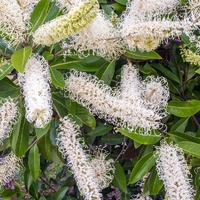Common name: Ivory curl
Other common names: Spotted silky oak
Description
Ⅰvory curl is a timber and flowering tree originating in Australia, its natural range limited to small areas of tropical rainforest forest in the continent's northeast.
In closely spaced forests, it may attain a height of up to 30 m (100 ft) with a straight, buttressed trunk 40 cm (1.3 ft) in diameter. On open sites, it is typically 5 to 10 m (15 to 30 ft) tall with a densely leafy rounded crown. The bark is grey, smooth on young trees, becoming rough, thick and fissured with age. Growth is moderate to fast, depending on the growing conditions.
Leaves are bronze-red or pink-tinged when young, becoming dark glossy green with a leathery texture. They change shape as they mature, from deeply lobed, in juvenile form, to entire, elongated-oval at maturity and remain on the tree throughout the year.
The flowers are creamy-white tubes coiled at the tip and closely arranged in bottle-brush-like flowering spikes up to 25 cm (10 in) long that hang from the ends of the branches. They bloom in summer in its native range, over a period lasting four to six weeks, and in such perfusion to nearly hide the green foliage from view. They are followed in autumn to winter by small pear-shaped fruit that mature to dark brown, then split open to release small, winged seed.

In full bloom (Toowoomba, Australia)

Flower clusters
Use
Ivory curl is commonly cultivated as a street tree, particularly in eastern Australia, for its shapely form and flowering display. The nectar-rich flowers also help nourish native bird and butterfly species and are useful to apiculture, providing pollen for brooding bees and nectar for honey production. The honey is similar to Macadamia's (Macadamia integrifolia), being light amber and mildly flavoured.
The sawn timber is used mainly for interior flooring and joinery work and the roundwood for turnery and other decorative woodcraft. The wood is heavy, averaging 940 kgs per cubic meter (59 lbs per cubic ft), and has pale, red-brown heartwood attractively patterned by spots, resembling a scattering of liquid droplets. Though heavy, it is not naturally resistant to rot and decay, which puts it in the non-durable hardwood class.
Climate
Grows naturally in moderately humid subtropical and tropical lowland to mid-elevation climates, generally areas with annual lows of 10 to 23°C, annual highs of 18 to 32°C, annual rainfall of 700 to 2300 mm and a dry season of 2 to 5 months. However, it reaches its best development as a timber tree in areas with annual rainfall of 1600 mm or more.
Growing
New plants are usually raised from seed, though cuttings are also used with reasonable success. It performs best on rich, moist, free-draining clay-loam, loam, sandy loam and loamy sand soils of a moderately acid to neutral nature, generally with a pH of 5.0 to 7.0, and on sites with full to partial sun exposure.
Problem features
There are no known problem features associated with this tree.
Where it grows
References
Books
-
Barwick, M., et al. 2004, Tropical & subtropical trees : a worldwide encyclopaedic guide, Thames and Hudson, London
-
Bristow, M. & Bragg, A. & Annandale. M. 2005, Growing rainforest timber trees: a farm forestry manual for north Queensland, Research and Development Corporation (RIRDC), Barton, A.C.T, Australia
-
Doran, J. C & Turnbull, J. W. 1997, Australian trees and shrubs : species for land rehabilitation and farm planting in the tropics, 2nd ed, Australian Centre for International Agricultural Research (ACIAR), Canberra, Australian Capital Territory
-
Holliday, I. 2002, A field guide to Australian trees, 3rd revised editon, New Holland Publishers, Frenchs Forest, New South Wales
-
Lake, M. 2015, Australian rainforest woods : characteristics, uses and identification, CSIRO Publishing, Collingwood, Victoria
-
Leech, M. 2013, Bee Friendly: A planting guide for European honeybees and Australian native pollinators, Rural Industries Research and Development Corporation (RIRDC), Canberra, Australian Capital Territory
-
Macoboy, Stirling 1982, Trees for flower and fragrance, Lansdowne Press, Sydney
-
Oakman, H. 1995, Harry Oakman's what flowers when : the complete guide to flowering times in tropical and subtropical gardens, University of Queensland Press, St. Lucia, Queensland
-
Peate, N. & Macdonald, G. & Talbot, A. 2006, Grow what where : over 3,000 Australian native plants for every situation, special use and problem area, 3rd ed., Bloomings Books, Richmond, Victoria, Australia



